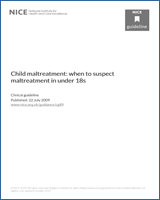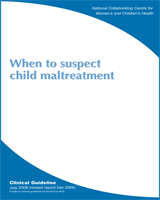Anogenital symptoms and signs
Suspectc sexual abuse if a girl or boy has a genital, anal or perianal injury (as evidenced by bruising, laceration, swelling or abrasion) and the explanation is absent or unsuitable.c
Suspectc sexual abuse if a girl or boy has a persistent or recurrent genital or anal symptom (for example, bleeding or discharge) that is associated with behavioural or emotional change and that has no medical explanation.
Suspectc sexual abuse if a girl or boy has an anal fissure, and constipation, Crohn's disease and passing hard stools have been excluded as the cause.
Considerc sexual abuse if a gaping anus in a girl or boy is observed during an examination and there is no medical explanation (for example, a neurological disorder or severe constipation).
Considerc sexual abuse if a girl or boy has a genital or anal symptom (for example, bleeding or discharge) without a medical explanation.
Considerc sexual abuse if a girl or boy has dysuria (discomfort on passing urine) or anogenital discomfort that is persistent or recurrent and does not have a medical explanation (for example, worms, urinary infection, skin conditions, poor hygiene or known allergies).
Considerc sexual abuse if there is evidence of one or more foreign bodies in the vagina or anus. Foreign bodies in the vagina may be indicated by offensive vaginal discharge.
Sexually transmitted infections
Considerc sexual abuse if a child younger than 13 years has hepatitis B unless there is clear evidence of mother-to-child transmission during birth, non-sexual transmission from a member of the household or blood contamination.
Considerc sexual abuse if a child younger than 13 years has anogenital warts unless there is clear evidence of mother-to-child transmission during birth or non-sexual transmission from a member of the household.
Suspectc sexual abuse if a child younger than 13 years has gonorrhoea, chlamydia, syphilis, genital herpes, hepatitis C, HIV or trichomonas infection unless there is clear evidence of mother-to-child transmission during birth or blood contamination.
Considerc sexual abuse if a young person aged 13 to 15 years has hepatitis B unless there is clear evidence of mother-to-child transmission during birth, non-sexual transmission from a member of the household, blood contamination or that the infection was acquired from consensual sexual activity with a peer.
Considerc sexual abuse if a young person aged 13 to 15 years has anogenital warts unless there is clear evidence of mother-to-child transmission during birth, non-sexual transmission from a member of the household, or that the infection was acquired from consensual sexual activity with a peer.
Considerc sexual abuse if a young person aged 13 to 15 years has gonorrhoea, chlamydia, syphilis, genital herpes, hepatitis C, HIV or trichomonas infection unless there is clear evidence of mother-to-child transmission during birth, blood contamination, or that the sexually transmitted infection (STI) was acquired from consensual sexual activity with a peer.d
Considerc sexual abuse if a young person aged 16 or 17 years has hepatitis B and there is:
no clear evidence of mother-to-child transmission during birth, non-sexual transmission from a member of the household, blood contamination or that the infection was acquired from consensual sexual activity and
a clear difference in power or mental capacity between the young person and their sexual partner, in particular when the relationship is incestuous or is with a person in a position of trust (for example, teacher, sports coach, minister of religion) or
concern that the young person is being exploited.
Considerc sexual abuse if a young person aged 16 or 17 years has anogenital warts and there is:
no clear evidence of non-sexual transmission from a member of the household or that the infection was acquired from consensual sexual activity and
a clear difference in power or mental capacity between the young person and their sexual partner, in particular when the relationship is incestuous or is with a person in a position of trust (for example, teacher, sports coach, minister of religion) or
concern that the young person is being exploited.
Considerc sexual abuse if a young person aged 16 or 17 years has gonorrhoea, chlamydia, syphilis, genital herpes, hepatitis C, HIV or trichomonas infection and there is:
no clear evidence of blood contamination or that the STI was acquired from consensual sexual activity and
a clear difference in power or mental capacity between the young person and their sexual partner, in particular when the relationship is incestuous or is with a person in a position of trust (for example, teacher, sports coach, minister of religion) or
concern that the young person is being exploited.



